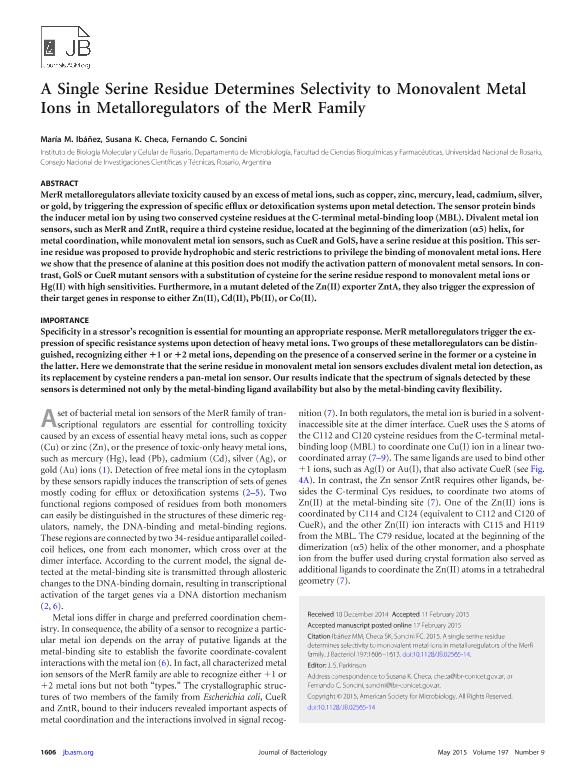Artículo
A single serine residue determines selectivity to monovalent metal ions in metalloregulators of the MerR family
Fecha de publicación:
05/2015
Editorial:
American Society for Microbiology
Revista:
Journal of Bacteriology
ISSN:
0021-9193
Idioma:
Inglés
Tipo de recurso:
Artículo publicado
Clasificación temática:
Resumen
MerR metalloregulators alleviate toxicity caused by an excess of metal ions, such as copper, zinc, mercury, lead, cadmium, silver, or gold, by triggering the expression of specific efflux or detoxification systems upon metal detection. The sensor protein binds the inducer metal ion by using two conserved cysteine residues at the C-terminal metal-binding loop (MBL). Divalent metal ion sensors, such as MerR and ZntR, require a third cysteine residue, located at the beginning of the dimerization (α5) helix, for metal coordination, while monovalent metal ion sensors, such as CueR and GolS, have a serine residue at this position. This serine residue was proposed to provide hydrophobic and steric restrictions to privilege the binding of monovalent metal ions. Here we show that the presence of alanine at this position does not modify the activation pattern of monovalent metal sensors. In contrast, GolS or CueR mutant sensors with a substitution of cysteine for the serine residue respond to monovalent metal ions or Hg(II) with high sensitivities. Furthermore, in a mutant deleted of the Zn(II) exporter ZntA, they also trigger the expression of their target genes in response to either Zn(II), Cd(II), Pb(II), or Co(II).
Palabras clave:
Metal Sensors
,
Merr Proteins
,
Toxic Heavy Metals
,
Non-Selective Detection
Archivos asociados
Licencia
Identificadores
Colecciones
Articulos(IBR)
Articulos de INST.DE BIOLOGIA MOLECULAR Y CELULAR DE ROSARIO
Articulos de INST.DE BIOLOGIA MOLECULAR Y CELULAR DE ROSARIO
Citación
Ibáñez, María Marta; Checa, Susana Karina; Soncini, Fernando Carlos; A single serine residue determines selectivity to monovalent metal ions in metalloregulators of the MerR family; American Society for Microbiology; Journal of Bacteriology; 197; 9; 5-2015; 1606-1613
Compartir
Altmétricas




